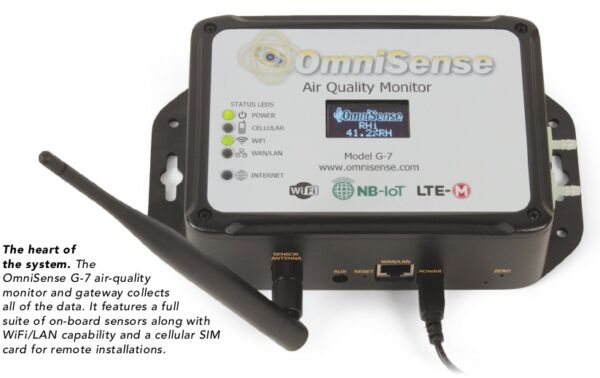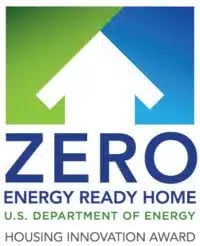
Reprinted with permission © 2021, The Taunton Press, Inc.
Why we need building sensors
The rapidly evolving field of sensor technology allows us to monitor building performance and create healthier indoor environments.

Photo: courtesy of author
Wood moisture meter. The OmniSense S-2 Wireless Sensor monitors temperature, humidity, and wood moisture content. This style of sensor with remote moisture probes is handy when you want to monitor the wood moisture in a different location than the temperature and humidity.
My friend Jake has a great saying: “Trust but verify.” In terms of building, this means we can exercise our skills in material choices and how we assemble them to make something that we believe wholeheartedly will work. But unless we take some sort of step to actually measure and quantify performance, how will we ever be sure? How will we ever diagnose? How will we ever improve?
Sure, we can wait for something to fail and forensically explore what went wrong, or we can cross our fingers and hope, but I’d rather be a bit more pragmatic. We’re at a crossroads of many streams of technology right now: Building and material sciences are progressing by the day, codes and client goals are elevating what we build, and electronics are becoming staggeringly more affordable and commonplace. In short, we’re assembling buildings that are far more advanced than at any time in history, and we have a flood of affordable user devices coming onto the market that allow us to measure and control their performance.
The need for information
I care about this opportunity for a few reasons. First and most important to me, we’re building houses that are highly insulated and super-airtight, so we need to be keenly aware of what’s happening with temperatures and humidity in the building’s components. People often correlate “low energy” homes with the idea of paying less for their utilities to service that home. While this is true, it’s a side effect of the physics of what we’re doing: We are literally reducing the molecular energy flowing through the components of our buildings. We add insulation to slow the transfer of heat, we add air barriers to stop the physical movement of air and its energy, and we use vapor retarders to control the dynamics of water vapor. We are reducing and controlling energy on a much broader scale than just what we use to heat and cool our homes. By doing this, we allow ourselves to have a much greater ability to influence what happens to the guts of our buildings, but this can be a delicate balance. If one aspect falls out of balance, it can have less-than-desirable consequences— mold, air-quality issues, or even catastrophic rot from water and air leaks.
So how do we measure what’s happening in our buildings? In particular, how do we measure what’s happening inside our walls and roofs over time? We can’t expect clients to let us come back into their house every month for years to drill holes in their walls and take measurements, nor can we expect them to allow us in to download data from sensors. So we need a system that we can install during construction, inside of walls, roofs, and other hidden areas, that can be left there for years, requiring no maintenance, all while communicating wirelessly. Such systems used to be restricted to the realm of research projects due to their high cost or intrusiveness. But with the rapid growth of technology, analytical-grade wireless sensors are now affordable enough that any builder who cares can easily justify the cost as a measure of due diligence or an investment in their own education.
What are we measuring?
The variable with the farthest-reaching influence is temperature. The temperature of an assembly can be the proverbial canary in the coal mine for so many things happening in our houses. At the obvious end of the spectrum, there’s the risk of an unoccupied home freezing and the potentially disastrous consequences if that happens. Wouldn’t it be great if we could set a temperature limit that triggers a series of notifications (email, text, phone call) that alert us that something has gone wrong at a client’s home and we need to take action to resolve it or notify them that there’s trouble afoot? That alone is worth the price of admission.
Moving into less immediate criteria, temperature can tell us just how well the HVAC system is maintaining the indoor environment: Is everything holding at a uniform level or are there wide swings between the thermostat set point and the actual temperature in the space? We can also get a look at how one wall compares to another due to its location or type of insulation. And finally, we can use temperature to assess the risk of other phenomenon in the wall. If a wall is getting “wet” but only while it’s cold, then there’s much less risk of mold or rot setting in.
issues with doors binding from swelling, trim and paint cracking, or wood flooring showing gaps or buckling.

Photograph by Rodney Diaz, Fine Homebuilding Magazine © 2021, The Taunton Press, Inc.
The second variable is wood moisture equivalent (WME). This is a measurement of how much water is in the wood that comprises the structure and decoration of the house. WME is expressed as a percentage of the wood that is water compared to the amount of wood that is, well, wood. For most climates and situations, we can expect to see WME somewhere between 6% and 20%; outside of this range, we run into issues. Early in the building process we can install sensors to monitor how our framing and sheathing are doing. If the wood structure of the building is too wet, it can lead to issues when insulation is installed or it can wreak havoc as it dries out with moisture building up behind vapor retarders or drywall. In the best-case scenario, you might have plaster or joint compound that’s slow to cure; at the other extreme, you can end up with large amounts of water from condensation that causes mold, rot, damaged insulation, or failing drywall. With a sensor monitoring system, we can watch moisture levels in the interior trim and millwork as the building ages. We know that the WME of wood in the conditioned space should be between 6% and 12% depending on the settings of the HVAC system and the season. If we watch these numbers in the first year or two of the building’s life, we can tune the systems and settings to avoid issues with doors binding from swelling, trim and paint cracking, or wood flooring showing gaps or buckling.
The third major variable sensors allow us to watch is humidity, the measurement of how much water is in the air around us. In practice, this is expressed by our sensors in two forms: absolute humidity and relative humidity. Absolute humidity is a physical measurement of the mass of water in a given volume of air. If we take the absolute humidity measurement and cross that with the air temperature, we get relative humidity, which is the measurement we’re most familiar with and most likely to use. Relative humidity is a percentage expression of how much water is in the air compared to how much it can actually hold; as temperatures go down, the air can physically hold less moisture, and vice-versa.
This matters for a number of reasons. The first and often most relevant is comfort. The human body is most comfortable in a range of relative humidity from 50% to 60%, and if we can measure these conditions we can tune the systems in the home to make sure the occupants aren’t experiencing any of the less-than-enjoyable side effects of being outside of this range (sinus issues, dry skin, nose bleeds, respiratory issues, sweating). The second reason we want to watch humidity is to ensure that the house itself isn’t at risk of any issues, most commonly from too much humidity. We can have issues with condensation on walls and windows resulting in mold growing, paint peeling, and wood components failing prematurely. Less noticeable but equally important is the buildup of moisture in our walls and roofs resulting again in mold and rot, which at best can cause unwanted odors and at worst can lead to health issues and catastrophic failure of the components.
The next thing to consider is dew point. Dew point is really a phenomenon expressed by the combination of temperature and humidity. We can all relate to the real-life experience of dew point when we pour a cold beverage and see the resulting sweat of water all over the side off the glass. In scientific terms, dew point is marked by the relationship between the temperature of a surface and the water in the air around it. When there’s a high enough level of humidity in the air and a lower-temperature surface, the water in the air changes phase from a gas to a liquid and collects on that cooler surface — the temperature at which the water condenses from the air at a given relative humidity onto that surface is the dew point. With a beverage, we can simply set it on a napkin or a coaster, but if this happens in a wall or roof over a long period of time, the results can be disastrous.
A final area of measurement that we’re implementing is indoor-air quality (IAQ). There are many particles and chemicals that can be measured in this area; to be frank, the research is still evolving and the sensors for some of them are cost-prohibitive. But a good starting point is to measure the carbon dioxide (CO2) levels in a home. We exhale CO2, and it needs to be removed via ventilation in order to provide a healthy environment for us to live well. CO2 is also a good analogue for other pollutants; it’s common for CO2 levels to rise at the same time that we see other pollutants rise.
Data collection
So what do we use to do this monitoring? For years, we relied on small HOBO data collectors (made by Onset) that we could use for short-term measurements that needed to be downloaded to a computer. These data collectors are still useful for diagnosing issues in existing buildings, but they don’t fit the needs of long-term remote monitoring. So what we’ve settled on is a system from the company OmniSense. The heart of the system is a wireless gateway (router) that collects the data from the sensors in the building and streams it live to a cloud-based host via a WiFi or LAN connection. This is the most visible part of the system, and we often install the gateway in the mechanical area or with the internet modem. OmniSense gateways range from $200 to $450. In terms of the sensors, there’s something available to measure just about anything you could possibly want in a residential building, and they all communicate wirelessly with the gateway.
“Unless we take some sort of step to actually measure and quantify performance … how will we ever improve?”
You can monitor all the parameters we’ve discussed so far, along with energy consumption, wind speed, wind direction, rainfall, solar radiation, water flow, differential pressure of the building, sound pressure levels, and a handful of others. The sensors are battery powered by a small lithium-ion cell that should deliver anywhere from 5 to 20 years of service depending on the collection rate of the sensor and environmental conditions; they sell for just over $50 a sensor. We primarily use the S-11 sensors, which monitor temperature, relative and absolute humidity, and wood moisture content. The small (roughly 2-in. by 3-in. by 3-in.) boxes affix to a part of the structure via two stainless-steel screws. These screws are critical, as they not only secure the sensor but are the “pins” of the moisture meter, and their length can be used to vary the measurement depth inside of the wood that you want to take readings from. We also have used the S-2 sensors, which are functionally identical to the S-11 but measure wood moisture via screws attached to wires. These sensors are handy if you have a tight spot from which you want readings, but the sensor body can’t fit. The final one we deploy is the S-19 CO2 monitor, which we generally locate in the master bedroom in a concealed spot. The highest levels of CO2 are typically measured in the middle of the night in bedrooms, the areas of a house where we spend the most time. These sensors are more expensive, costing about $250 each.
Sensor placement
Placement depends on the project. In general, we bury one sensor at the sheathing plane of a north wall because it will see the least sun exposure, which also translates to drying (we all know the north side is the first to rot). We will usually install one sensor in the attic or roof assembly, and especially in any unvented roof sections. Inside the house, I’ll find a spot inside a closet or cabinet to tuck one away out of sight; this sensor gives us an interior base measurement to relate any of the assembly sensors to. If we’re seeing elevated moisture inside a wall, we can compare it to interior levels to quickly see if a change needs to be made to the interior environment or if the moisture is coming from somewhere else. The final option is to place one in a weather- protected location on the exterior of the building. This allows us to relate our data to the weather conditions the building is experiencing.
So what have we learned? In short, we’ve learned both a bunch and then again not much. For the most part, we’ve found that our assemblies are performing as they should, but we’ve been able to gain a much deeper understanding of how they’re doing it. The ability to quickly toggle between measurements, locations, and time periods and have them graphed out instantly in front of our eyes is a tremendous learning experience. In the interest of full disclosure, we were able to catch a potential issue in an unvented roof assembly that we had concerns about from day one. It was a perfect storm of less than- stellar insulation installation and a circuitous ERV duct run that led to some elevated humidity levels beyond what we’re comfortable with. It has cost us some time and money to correct, but that cost is much less than the potential damage that could have resulted if we hadn’t caught it through monitoring. That intervention right there is well worth the cost of implementing these tools.
Ben Bogie is a lead carpenter with Kolbert Building in Portland, Maine.
Building Matters: Why we need building sensors,” first appeared in Fine Homebuilding magazine’s issue #296, Dec 2020/Jan 2021.












